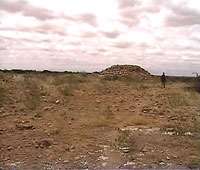Somali mythology
 |
| Part of a series on the |
| Culture of Somalia |
|---|
| Culture |
| People |
| Religion |
| Language |
| Politics |
|
Somali mythology covers the beliefs, myths, legends and folk tales circulating in Somali society that were passed down to new generations in a timeline spanning several millennia. Many of the things that constitute Somali mythology today are traditions whose accuracy have faded away with time or have transformed considerably with the coming of Islam to the Horn of Africa.
The culture of venerating saints and the survival of several religious offices in modern Somalia show that old traditions of the region's ancient past had a significant impact on Islam and Somali literature in later centuries. Similarly, practitioners of traditional Somali medicine and astronomy also adhere to remnants of an old cultural belief system that once flourished in Somalia and the wider Horn region.
Pre-Islamic period

The Somali people in pre-Islamic times are believed to have adhered to a complex henotheistic belief system, with a set of deities superseded by a single all-powerful figure called Eebe (God, also known as Waaq). The equilibrium of the Universe in Somali mythology was tied with the love between a bull and a cow. The Universe was said to balance itself on the horns of a bull, a beast forever staring at the cow tied to a pole in front of him. Whenever his love turned her eyes away from the bull, it would result in a physical shift that caused natural disasters on Earth.[1] Religious temples dating from antiquity known as Taalo were the centers where important ceremonies were held led by a Wadaad priest.
Deities
| Eebo
(God) |
Eebo is the Somali word for God and was synonymously used for the ancient Cushitic Sky God Waq. According to Somali Legend Eebo lived in the Heavens and whenever the nomads successfully prayed for rain it was known as Barwaaqo (God's rain)[2] |
| Ayaanle (Angels) | The Ayaanle in Ancient Somalia were known as the good spirits and acted as mediators between God and humans. They were said to be bringers of luck and blessings. |
| Huur (Reaper) | Huur was the messenger of Death and had the form of a large bird. The deity was akin to Horus of ancient Egypt and played a similar role in Somali society. |
| Nidar (Punisher) | Nidar was the righter of wrong. He was considered the champion of those that were exploited by their fellow humans. The deity has survived in modern Somalia as a popular saying; Nidar Ba Ku Heli ("Nidar will find [and punish] you"). |
Legendary kings, queens and saints
In Somali mythology, there is an abundance of tales about men and women who defied cultural traditions or acquired heroic and saintly status amongst the masses of the Somali Peninsula.
| Arawelo (Queen) | Arawelo was a legendary queen in ancient Somalia who is said to have subdued all men in her kingdom and promoted matriarchal values in stark contrast with the traditional patriarchal society of Somalia. |
| Wiilwaal (King) | Wiil Waal was a legendary king in ancient Somalia known for his bravery and skills in battle. |
| Bucur Bacayr (King) | Bucur Bacayr was a legendary king of the Yibirs in northern Somalia. |
Giants and demons
| Habbad ina Kamas
(Giant) |
Habbad ina Kamas was a legendary cruel giant who ruled half of ancient Somalia. Habbad oppressive rule was the complete opposite to the kindness and care that was bestowed upon the other half of the land ruled by the giant Biriir ina Barqo. He was eventually defeated and slain in battle by Biriir, when the latter found out about Habbad's tyranny. |
| Biriir ina Barqo
(Giant) |
Biriir ina Barqo was a legendary heroic giant in ancient Somalia known for his just rule and kindness. He lived in a cave called Shimbiraale (the cave of birds) and used to wear a heavy ring that no man could lift. He answered the pleas of those suffering under the rule of the giant called Habbad and defeated him in battle. He then united the two lands and ushered in a long period of peace.[3] |
| Qori ismaris ("One who rubs himself with a stick") | Qori ismaris was a man who could transform himself into a "Hyena-man" by rubbing himself with a magic stick at nightfall and by repeating this process could return to his human state before dawn. |
| Dhegdheer ('"One with long ears") | Dhegdheer was a female cannibalistic demon who hunted in Somali forests. Her victims were usually wandering or lost children. Very similar to the cannibalistic witch living deep in the forest in the German folktale Hansel and Gretel. |
Mythological places
Many regions of Somalia have cities or specific areas whose names corroborate the stories told in Somali mythology. Places such as Abudwaq, Ceel Waaq ("Well of God"), waaq-ooyi("north") and other similar towns with the name Waq in it suggest a relation to the old Waaq worship practiced in the Horn. The Tomb of Arawelo is another popular mythological place in Somalia said to be the final resting place of Queen Arraweello. In modern times, it is considered an important place for Somali women.
References
- ↑ Gifts by Nuruddin Farah, p. 94.
- ↑ Culture and Customs of Somalia by Mohamed Diriye Abdullahi, p. 65.
- ↑ Folktales from Somalia by Ahmed Artan Hanghe, p. 144.